

Eight tools for peer and self assessment. Peergrade - engaging student peer review. Which platform would you use? - Poll Results. Your free virtual room for up to 12 participants. Beautiful Free Images & Pictures. Principle 3. Teachers plan meaningful lessons that promote language learning and help students develop learning strategies and critical thinking skills.

These lessons evolve from the learning objectives. Some Practices for Principle 3 Teachers use comprehensible input to convey information to students. Comprehensible input is of primary importance for progress in the target language. Whether oral or written, comprehensible input helps English learners understand the meaning of the communication. BC Planning for Differentiation handout RRoberts. Seminars motivating. My Classroom Economy.
Free guides. How to say or pronounce Shrouk - PronounceNames.com. Designing and organising your course. Core Practice for Inclusive Online Teaching. Online Voice Recorder - Record Voice from the Microphone. - Create. Make Videos and Animations Online. Online voice recorder. Teaching YL Online - September 2020. Assignments. Assessing learners online: noticing, self-checking and online quizzes. Assessing learners online: assessment criteria. Assessment for Learning. What is Assessment for Learning?
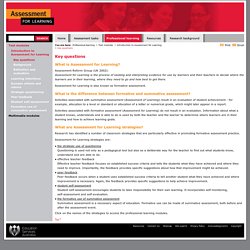
Assessment Reform Group (UK 2002):Assessment for Learning is the process of seeking and interpreting evidence for use by learners and their teachers to decide where the learners are in their learning, where they need to go and how best to get there. Assessment for Learning is also known as formative assessment. What is the difference between formative and summative assessment? Activities associated with summative assessment (Assessment of Learning) result in an evaluation of student achievement - for example, allocation to a level or standard or allocation of a letter or numerical grade, which might later appear in a report. 18 Of The Best Formative Assessment Tools For Teachers [Updated] Contributed by Ryan Schaaf, Assistant Professor of Technology, Notre Dame of Maryland University This is sponsored content. You can read more about our sponsored content policy here. Do they get it? After an instructional lesson is over, educators are left with a classroom full of students looking at them.
Did my students get the lesson? Getting student feedback. Even from the age of 6 or 7 children can be encouraged to think for themselves about their learning and what goes on in class.
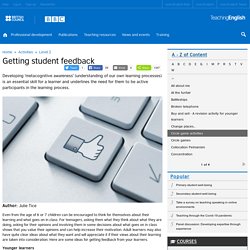
For teenagers, asking them what they think about what they are doing, asking for their opinions and involving them in some decisions about what goes on in class shows that you value their opinions and can help increase their motivation. Adult learners may also have quite clear ideas about what they want and will appreciate it if their views about their learning are taken into consideration.
Here are some ideas for getting feedback from your learners. Younger learnersAt the end of the lesson show picture cards to illustrate different activities. Did we learn new words today? Review Teaching Young Learners Online. Digital Tools for Giving Feedback. Apparently, the term originates in biology when a response comes back to an organism (Rinvalucri,1994) but coming from an engineering background, I had my own idea of the word ‘feedback’ when I first started to teach.
Having now taught English for more than 15 years, it has a different meaning to me. People study English to get feedback on their language skills, their progress and the tasks they complete. It is hard to find someone who doesn’t like or want to be corrected. After all, speaking correctly and properly is one of the reasons people attend language/skills courses.
(127) Using screencast-o-matic to provide feedback on writing. Practical Ideas for Classroom Formative Assessment. We are all better at spotting mistakes in the work of others.
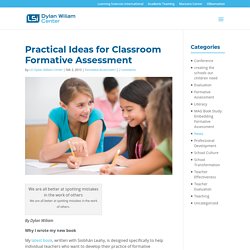
By Dylan Wiliam Why I wrote my new book My latest book, written with Siobhán Leahy, is designed specifically to help individual teachers who want to develop their practice of formative assessment on their own or with small groups of colleagues. In this blog, I provide some suggestions for practical techniques you can try in your classroom right now.
Next month, I’ll focus on tips and strategies for how you can work with others to gain support for the difficult work of changing practice. Technique 1: Start with samples of work, rather than rubrics, to communicate quality As an adult in the professional world, if someone were to ask you to write a business plan or create a product brochure and the task was somewhat unfamiliar to you, what’s the first thing you might do to get help? As you examine these examples, you might be able to pick out the high-quality vs. low-quality ones, and even identify why you think this is so. Teaching online - using your coursebook and ideas for breakout rooms. About the webinar The British Council is committed to supporting the use of technology for the continuation of education in a crisis.
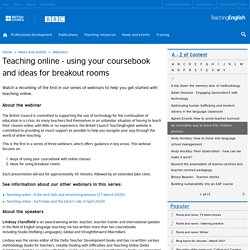
As many teachers find themselves in an unfamiliar situation of having to teach their classes online, with little or no experience, the British Council TeachingEnglish website is committed to providing as much support as possible to help you navigate your way through the world of online teaching. This is the first in a series of three webinars, which offers guidance in key areas. This webinar focuses on: Ways of using your coursebook with online classes Ideas for using breakout rooms Each presentation will last for approximately 30 minutes, followed by an extended Q&A clinic. Handouts for Webinar Breakout room ideas. Empower Every Voice. The mystery of the sand. The mystery of the sand. (127) IATEFL: global get-together Final Panel. Teaching English online. Teacher Support Pack - Global - 2.
Cookies We use necessary cookies to make our site work.

We'd also like to set optional analytics cookies to help us improve it. We won't set optional cookies unless you enable them. Using this tool will set a cookie on your device to remember your preferences. For more detailed information about the cookies we use, see our . Cookie Information PageTiger View Policy. Support for teachers and teacher educators. The British Council is committed to supporting the use of technology for the continuation of education in a crisis.

As many teachers find themselves in an unfamiliar situation of having to teach their classes online, with little or no experience, the British Council TeachingEnglish website is committed to providing as much support as possible to help you navigate your way through the world of online teaching. Below is a list of initiatives that we are currently providing, or planning to provide in the coming weeks. TeachingEnglish.
THE EDUCATION HUB – For research-led teaching. Eight tools for peer and self assessment. 10 tools for effective peer feedback in the classroom - Ditch That Textbook. Providing feedback is an important skill. The ability to give meaningful feedback to our peers is even more powerful. Here are 10 tools for effective peer feedback in the classroom. As teachers, we strive to provide our students with quality feedback on their work. 7 Tips For Peer And Self-Assessment. Christina Brown Christina is an Art and Design Teacher in a London secondary school.

In her third year of teaching, she has also just completed an MA in Art and Design in Education at The Institute of Education (University College London). Peer and self-assessment. Learners are much better at giving each other accurate and sensitive feedback than we suspect, and this activity gives them the opportunity to demonstrate it.
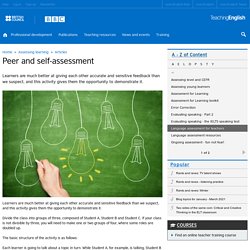
Divide the class into groups of three, composed of Student A, Student B and Student C. If your class is not divisible by three, you will need to make one or two groups of four, where some roles are doubled up. The basic structure of the activity is as follows: Each learner is going to talk about a topic in turn. For Parents. What Do Families See When They Access Their Parent Accounts? From the Web Curious to see what ClassDojo looks like for families?
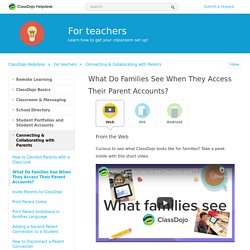
Take a peek inside with this short video. When a parent logs into their account via the web, they can do any of the following: View, like, and/or comment on any Class Story, School Story, or Portfolio posts in their newsfeed (Please note:You can learn more about how to moderate comments on posts here) View their student’s Reports up to two weeks ago View and respond to Messages exchanged with teachers (Please note:If you have your Quiet Hours set when a parent views their Messages, they will automatically see this notification: “It is [teacher]'s quiet hours. (127) Graham Stanley: Online Conversations in Escape Room Games WORKSHOP. Connecting Classrooms. Escape Rooms in ELT – Escape Room game ideas for English Language Teaching.
How to make your school's digital penpal project a success. Digital tools for penpalling in your classroom. British Council teacher and trainer Melissa Thomson shares her favourite digital tools to connect penpals who are learning English. Over the past few years, learners from my primary, teenage and adult classes have met digital penpals in Japan, Algeria, Scotland, Greece, the United Arab Emirates and Oman.
I had a penpal as a child I grew up in Scotland, and every month I wrote to a girl in Australia. She was my cousin's neighbour, who I'd never met in person. She was my age, and also went to dance class. Planning what I would write, and writing by hand, made me slow down and be creative. At first, I organised a penpal project with my class the old-fashioned way. Interactive Field Trips. Virtual Field Trip Apps and Websites. How to Make the Most of Virtual Field Trips. This how-to article accompanies the feature "Internet Explorers: Virtual Field Trips Are More Than Just Money Savers.
" How do you keep virtual field trips from becoming the modern-day version of the filmstrip -- something students just passively watch? A few tips from the pros: Have a Goal "One thing I look for is a purpose," says Angie Haynes, a media specialist at Altamaha Elementary School, in Baxley, Georgia, who is a fan of virtual field trips.
Covid-19 support for parents. The LearnEnglish Kids team want to support parents at this challenging time. British Council LearnEnglish KidsLearnEnglish Kids for parents. Helping parents and caregivers to support remote learning at home. Creative activities for Language Learners at home. Helping parents and caregivers to support remote learning at home. Parents and young learners in English language teaching: global practices and issues in school–home contacts. Assessment for Learning. Assessment for Learning. PowerPoint Presentation. Dreams. English songs, stories and videos for kids. Reading practice for kids. Have fun learning English. English listening skills practice.
English reading skills practice. Free Reading Passages and Literacy Resources. BritLit - Using literature in EFL classrooms. This booked published by Associació de Professors d'Anglès de Catalunya (APAC) helped to launch the BritLit initiative at the APAC Congress in February 2009. It coincided with a visit to schools in the city of author Louise Cooper, who also contributes to this book, and a short series of workshops for teachers about the project. This slightly revised version has been produced because it was recognised that teachers worldwide would be interested in the contents, not just those fortunate enough to live in Catalonia. The contents cover the whole range of BritLit activity in that the voices of teachers and authors are heard along with some comments from students, as well as more detailed studies from the project team and academics.
Introduction to grammar. Lessons Worth Sharing. Teaching young learners online: Reading and listening resources. Motivating pupils to read. This article describes ways to generate initial motivation, the second one shows how to maintain this motivation. Motivation Creating the basic motivational conditions Generating initial motivation References Motivation Motivation is one of the key factors that determine the rate and success of L2 attainment. It provides the main incentive to initiate learning a foreign language and later the determination to persevere and sustain the long and often difficult learning process.
Without sufficient motivation, even individuals with the best of abilities cannot accomplish long-term goals. Teachers working in state schools are first and foremost supposed to teach the curriculum, but we cannot ignore the fact that this cannot happen without motivating our learners. Creating the basic motivational conditions Create a pleasant and supportive learning environment. Encourage peer support groups which recognise individual pupils' interests, levels, skills and strengths.
Motivating speaking activities. At this age, the learners aren't motivated by new language, they're motivated by an activity. It can be very difficult to get them to speak if they really don't see the point. You can approach this by focussing on the following. The function of the language and using an authentic or near authentic task (e.g. get them to sit back-to-back to practise speaking on the telephone).A motivating task, which uses the language you want them to practise (e.g. students write questions on small squares of paper using the target language, then form the papers into a board game to be played using dice and counters).
Here are some possible examples, which apply to one or a combination of the above. Getting teenagers talking. Why it's important Long-term and short-term memoryLanguage fitness & agilityAuthenticityWhy they don't use English Peer pressure Lack of motivation Lack of support How we can get students talking Explain why it's important Confidence tricks Attainable goals Conclusion Why it's important. Getting teenagers to talk. Keep the conversation peer centred: plenty of pair or small group collaboration.Avoid asking discussion questions around the class: this puts them in the spotlight and causes potential embarrassment in front of friends.
You also risk dominating the talk.Give them a concrete list of statements or opinions: help them to choose their own ideas. Strategies to Build Intrinsic Motivation. Punishment, Rewards, and Commitment The issue with classroom management policies in most institutions is that it operates on a carrot-and-stick model. Carrots include PBIS (Positive Behavior Intervention and Supports), Classroom Economy, and other class rewards. Motivating the unmotivated.
How to Motivate Students in the Online Learning Environment. “Correction does much, but encouragement does more“ Johann Wolfgang von Goethe. 5 e-Learning Tips to Keep Younger Students Motivated. Introduction to grammar. Core Practice for Inclusive Online Teaching. Inclusive Teaching Checklist. Differentiated Instruction: How to Make Lessons Accessible for All. Rachael Roberts - Planning for differentiation. SCHMIDT The role of consciousness in second language learning. Deb Roy: The birth of a word. Noticing. Netflix and learn – six ways to teach English language skills with television. (63) Webinar with Dr Stephen Krashen. Books and Articles by Stephen D Krashen. Can we learn a second language like we learned our first? (63) Stephen Krashen on Language Acquisition.
Creative Spaces in Distance Learning. Integrating Physical Activity Into Distance Education - Texas A&M Today. Video Backgrounds for Teachers (FREE Download) “Jump Around!” The Benefits of Movement in the Online Learning Process. Building Rapport in the Online Classroom. Guess what the photos are.